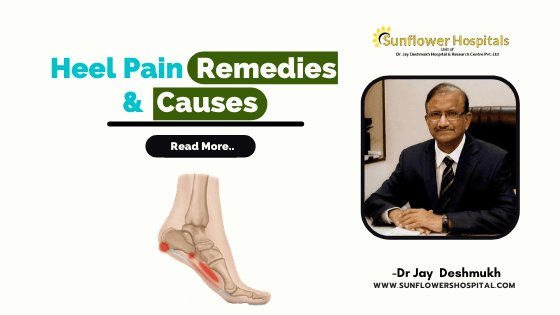Pain at heels is a very common symptom, partkulady in sportsmen or due to overuse or injury at the heel. Our ankle and our foot are made of 26 bones, 33 joints and 100 ligaments. The largest bone in our foot is our heel. There are many different causes of heel pain and at times the diagnosis and treatment are quite challenging.
What are the common causes of heel pain?
Plantar fasciitis, calcaneal spurs are common causes of pain at the heels. Inflammation of Achilles’ tendon, bursitis, Ankylosing spondylitis, reactive arthritis, sprains and strains are some other causes. Peripheral neuropathy in diabetics or bone infection can be responsible for heel pain. When to see a doctor? If the heel pain does not improve by home remedies or gets worse in spite of simple pain-relieving medications, then you need to see a doctor. If there is severe pain or redness at the heel, if there is numbness, tingling or if the pain follows a local injury then you need to see a doctor immediately.
What Is plantar fluidity?
This causes stabbing like pain at the foot, near the heel. The pain is very severe on awakening, when you put your first foot forward, or after prolonged rest. The pain is usually worst after exercise and not during exercise.
What are the risk factors associated with plantar fasciitis and what are the basics of treatment?
It is more common between 40 to 60 years. Long-distance running and some other exercises can contribute to pain. Flat feet, high arched foot, obesity can be associated with plantar fasciitis. Standing on hard surfaces for too long can cause dam• age to the plantar fascia and trigger pain. Just maintain-ing proper weight, using supportive shoes, applying ice and stretching your arches may help. Local steroids injections, physical therapy, ultrasonic tissue repair, night splints, custom-fitted arch supports are useful.
What about arthritis and heel pain?
If on awakening from sleep you experience pain at back, neck and heels and the stiff-ness remain for more than an hour you are likely to have heel pain in association with arthritis. This could be associated with ankylosing spondylitis, psoriasis, inflammatory bowel disease or reactive arthritis.
What is a calcaneal or heel spur?
A bony deposit in the region of the heel seen on x-ray is a spur. It is due to calcium deposition. Heel spurs may be caused by arthritis, excess body weight, poorly fitted shoes, wearing worn-out shoes and wearing flip flops too often. Using ice packs, local injections of steroids, short term pain-relieving drugs, physical therapy, exercises and stretching and use of heel pads may help.
What investigations are required if you have pain at the heels?
Checking for diabetes, Uric acid and routine blood evaluation may be required. Assessment of blood supply and nerve function may be required. Certain blood tests for arthritis and a simple x-ray of the foot including the heel is often done. However, in most cases, the simple clinical examination can help your doctor to arrive at a diagnosis
What are the general pre-cautions required to prevent pain at the heel?
Well-fitting appropriate footwear is the most important. Treatment of associated conditions like arthritis, diabetes, obesity may be required. Proper physical activity and exercises of the feet are recommended. Pain at the heel is a common symptom. There are many causes of heel pain. Judicious clinical examination and simple tests can help the doctor to arrive at the correct diagnosis. Proper exercises, well-fitting and appropriate footwear and avoiding obesity are the key aspects for avoiding heel pain.
Author: Dr Jay Deshmukh
Dr Jay Deshmukh is Chief Physician and Director, Sunflower Hospital, Nagpur Honorary Physician to Honorable Governor of Maharashtra and PondicherryCentral. Dr Jay Deshmukh is an M.B.B.S., M.C.P.S., F.C.P.S., M.N.A.M.S., MD From Internal Medicine – Bombay and New Delhi.


